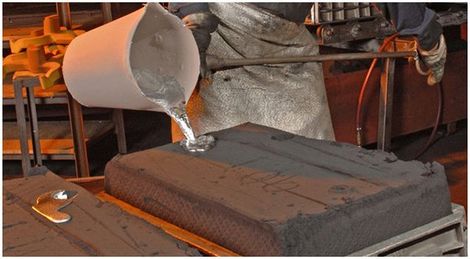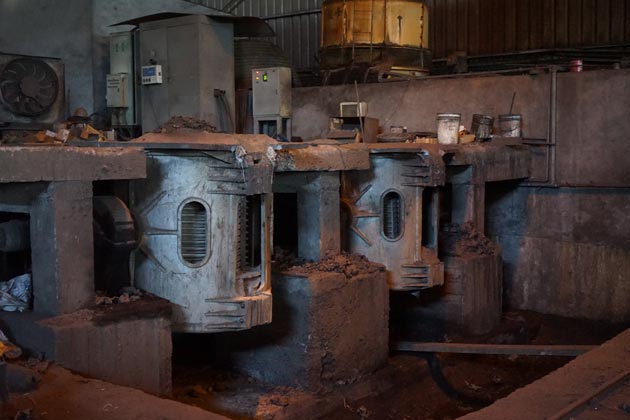Key strengths of choosing a professional Aluminum Foundry for your next project
Discover the Innovative Techniques Made Use Of in a Metal Foundry for Superior Casting Results
In today's competitive production landscape, metal foundries are progressively adopting ingenious techniques to enhance spreading results - Aluminum Foundry. Advanced computer simulations permit for exact modeling of liquified metal habits, while 3D printing allows rapid manufacturing of complex molds. In addition, green products and automation enhance procedures. These advancements assure significant enhancements in efficiency and quality assurance. The influence of these technologies on sustainability and production techniques continues to be to be fully discovered.
Advanced Computer System Simulations in Metal Casting
Advanced computer system simulations have revolutionized the metal spreading process by boosting accuracy and performance. These innovative tools enable designers to produce online designs of cast components, enabling them to evaluate and predict the behavior of liquified metal throughout the casting phase. By simulating various criteria such as temperature, circulation rate, and air conditioning rates, makers can recognize prospective problems before physical manufacturing begins.
This aggressive method reduces waste and decreases pricey mistakes, inevitably causing enhanced product high quality. In addition, simulations help with the optimization of mold and mildew layouts, guaranteeing that they satisfy the details needs of each job. The assimilation of computational fluid characteristics (CFD) and finite component evaluation (FEA) further adds to the accuracy of these simulations, offering insights that were previously unattainable. Because of this, advanced computer system simulations have come to be a vital component of contemporary metal foundries, considerably advancing the market's capacities.
3D Printing for Molds and Patterns
3D printing has emerged as a groundbreaking method for developing molds and patterns in the metal foundry industry. This innovation allows the rapid manufacturing of complex geometries that standard production methods have a hard time to accomplish. By using additive production, foundries can create complex layouts with decreased lead times and product waste. The capacity to produce molds as needed enables greater flexibility in style models, promoting faster prototyping and modifications.
3D printing can utilize a selection of products, including plastics and metals, tailored to specific casting needs. This adaptability improves the precision of molds, leading to exceptional casting outcomes with enhanced surface area finishes. Additionally, the decrease in the variety of components required simplifies assembly procedures, further optimizing manufacturing effectiveness. As foundries remain to take on 3D printing, they are poised to redefine industry requirements, leading the way for development and boosted performance in metal spreading procedures.
Eco-Friendly Materials and Processes
As the metal foundry industry deals with enhancing stress to decrease its environmental footprint, the adoption of green materials and processes has actually come to be essential. Foundries are now checking out sustainable choices to typical materials, such as using recycled metals and bio-based binders. These materials not only decrease waste yet also reduced power usage during manufacturing.
Furthermore, innovations in sand spreading strategies have resulted in the use of artificial sands that are much less harmful to the environment. Shops are also implementing ingenious processes like liquified metal therapy that decreases emissions and boosts the high quality of actors items.
Furthermore, water-based coverings have actually replaced harmful solvents, advertising a more secure work atmosphere (Aluminum Casting). By incorporating these green techniques, metal foundries can significantly decrease their ecological effect while keeping top notch spreading results. This change not only profits the atmosphere however likewise aligns with the growing customer need for lasting manufacturing solutions
Automation and Robotics in Foundry Workflow
While the metal foundry industry welcomes click to read more advancement, the integration of automation and robotics is changing procedures greatly. Automated systems improve procedures such as mold and mildew production, metal putting, and casting finishing, greatly improving effectiveness. Robotics promote the handling of heavy materials, decreasing the danger of work environment injuries and guaranteeing more secure atmospheres.

Even more, making use of automated led automobiles (AGVs) maximizes product transport within centers, making certain timely delivery of parts to suitable workstations. By carrying out these modern technologies, foundries can adjust to varying needs with better agility, eventually leading to improved success and competitiveness in the market. As automation and robotics proceed to evolve, they hold the possible to redefine typical foundry methods and drive further innovations in casting strategies.
Real-Time Monitoring and Top Quality Control Techniques
The innovations in automation and robotics have actually led the way for much more advanced strategies to high quality assurance in metal foundries. Real-time tracking systems use innovative sensing units and data analytics to track vital criteria throughout the casting procedure. These systems continuously evaluate variables such as temperature level, material, and pressure composition, allowing prompt detection of variances from developed criteria.
Quality assurance techniques now integrate equipment learning algorithms that evaluate historical data to anticipate possible issues prior to they occur. This aggressive technique minimizes waste and improves general manufacturing performance. Additionally, integrated feedback loopholes permit for quick adjustments, guaranteeing that each casting satisfies strict top quality needs.
The execution of electronic doubles-- digital reproductions of physical properties-- has actually additionally revolutionized quality control, enabling engineers to simulate and maximize procedures in real-time. Together, these Aluminum Casting ingenious techniques greatly improve the integrity and top quality of spreadings, establishing brand-new market requirements in metal foundry procedures.
Often Asked Questions
What Sorts of Metals Are Typically Cast in Shops?
Typically cast steels in foundries include light weight aluminum, bronze, brass, and iron. Each metal exhibits special residential or commercial properties, making them ideal for various applications, such as vehicle parts, machinery, and imaginative sculptures, improving their versatility in production.

Exactly how Lengthy Does the Casting Process Normally Take?
The casting process normally takes several hours to days, relying on factors such as the complexity of the mold and mildew, sort of metal utilized, and air conditioning needs. Each phase influences the overall period considerably.
What Precaution Remain In Area for Foundry Workers?

Just how Are Problems in Castings Identified and Addressed?
Problems in castings are identified through visual inspections and non-destructive screening approaches. When detected, foundry employees address them by improving procedures, changing material compositions, and implementing rehabilitative actions additional info to ensure top quality and compliance with criteria.
What Is the Cost Range for Metal Casting Providers?
The price array for metal spreading services normally ranges $1 to $10 per extra pound, depending on factors such as product type, intricacy of the style, and production quantity, impacting general pricing significantly.
In today's competitive manufacturing landscape, metal foundries are significantly adopting cutting-edge techniques to improve casting outcomes. As the metal foundry market encounters boosting stress to minimize its environmental impact, the adoption of eco-friendly products and processes has actually become crucial. Factories are currently checking out lasting options to typical materials, such as making use of bio-based binders and recycled steels. By incorporating these environment-friendly practices, metal foundries can considerably lower their environmental influence while maintaining high-grade casting outcomes. The advancements in automation and robotics have actually led the method for more advanced strategies to quality guarantee in metal foundries.